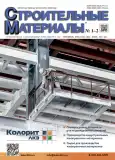On the Issue of Ensuring the Durability of Products and Structures Made of High-Strength Concrete to Explosive Destruction
- Authors: Akhtyamov R.Y.1, Ahmed’yanov R.M.1, Gamaliy E.A.1, Averina G.F.1
-
Affiliations:
- “Ural Research Institute of Building Materials” LLC
- Issue: No 1-2 (2024)
- Pages: 90-94
- Section: Modern concretes
- URL: https://ter-arkhiv.ru/0585-430X/article/view/635974
- DOI: https://doi.org/10.31659/0585-430X-2024-821-1-2-90-94
- ID: 635974
Cite item
Abstract
Fire safety procedures are an integral part of the design process of civil and industrial construction facilities. When carrying out design calculations, up-to-date reference data on the resistance of known types of building materials to the effects of open fire and elevated temperatures are used. However, modification of the compositions and properties of such materials may cause changes in their behavior in fire conditions. Thus, new types of high-strength concretes based on Portland cement in practice have shown a tendency to explosive destruction, which significantly affects the reliability of the simulation results of their resistance to prolonged and short-term exposure to elevated temperatures. The presented work provides an overview and assessment of the current state of the issue of ensuring fire safety of structures made of high-strength concrete, additional measures are proposed to improve the existing algorithms for determining their fire resistance.
Full Text
About the authors
R. Ya. Akhtyamov
“Ural Research Institute of Building Materials” LLC
Author for correspondence.
Email: sekr@7359808.ru
Candidate of Sciences (Engineering)
Russian Federation, ChelyabinskR. M. Ahmed’yanov
“Ural Research Institute of Building Materials” LLC
Email: lab@2170812.ru
Candidate of Sciences (Engineering)
Russian Federation, ChelyabinskE. A. Gamaliy
“Ural Research Institute of Building Materials” LLC
Email: eagamaliy@mail.ru
Candidate of Sciences (Engineering)
Russian Federation, ChelyabinskG. F. Averina
“Ural Research Institute of Building Materials” LLC
Email: avergf@gmail.com
Candidate of Sciences (Engineering)
Russian Federation, ChelyabinskReferences
- Neville A., Aitcin P.C. High performance concrete - An overview // Materials and structures. 1998. Vol. 31, pp. 111–117.
- Bazhenov Yu.M., Demyanova V.S., Kalashnikov V.I. Modifitsirovannyye vysokokachestvennyye betony [Modified high-quality concrete]. Moscow: ASV. 2006. 368 p.
- Pushenko A.S., Azarov V.N. Assessment of the effect of high fire temperatures on the properties of high-strength concrete. Vestnik of the Volgograd State University of Architecture and Civil Engineering. Series: Construction and architecture. 2007. No. 7, pp. 143–147. (In Russian).
- Pushenko A.S. On the issue of the strength of high-strength concrete and reinforced concrete columns under the influence of fire. Izvestiya of the Kazan State University of Architecture and Civil Engineering. 2008. No. 1 (9), pp. 116–121. (In Russian).
- Pukharenko Yu.V., Kostrikin M.P. Resistance of fibrobetone to high temperature effects. Stroitel’stvo i rekonstruktsiya. 2020. №. 2. pp. 96–106. (In Russian).
- Hedayati M., Sofi M., Mendis P., Ngo T. A com- prehensive review of spalling and fire performance of concrete members. Electronic journal of structural engineering. 2015. Vol. 15, pp. 8–34. doi: 10.56748/ejse.15199
- Jansson R. Fire spalling of concrete: theoretical and experimental studies: Dis. … PhD. Royal Institute of Technology. 2013. 154 p.
- Kuznetsova I.S., Ryabchenkova V.G., Kornyushi- na M.P., Savrasov I.P., Vostrov M.S. Polypropylene fiber is an effective way to struggle with the explosion-like destruction of concrete in case of fire. Stroitel’nye Materialy [Construction Materials]. 2018. No. 11, pp. 15–20. DOI: https://doi.org/10.31659/0585-430X-2018-765-11-15-20 (In Russian).
- Bazant Z. Analysis of pore pressure, thermal stress and fracture in rapidly heated concrete, international workshop on fire performance of high-strength concrete. Proceedings. Appendix B: Workshop Papers.1997. B10, Gaithersburg, MD, (online), https://tsapps.nist.gov/publication/get_pdf.cfm?pub_id=916655 (Accessed January 30, 2024)
- Bazant Z.P., Kaplan M.F. Concrete at high temperatures: material properties and mathematical models. Longman Group Limited.1996. 410 p.
- Bažant Z.P., Thonguthai W. Pore pressure in heated concrete walls: theoretical prediction. Magazine of Concrete Research. 1979. Vol. 31. Iss. 107, pp. 67–76. https://doi.org/10.1680/macr.1979.31.107.67
- Klingsch E.W. Explosive spalling of concrete in fire. Report. ETHZurich. 2014. https://doi.org/10.3929/ethz-a-010243000
- Novikov N.S. Fire resistance of fiber-reinforced concrete structures for road tunnels and subways. Dis... Candidate of Sciences (Engineering). Moscow. 2019. 167 p. (In Russian).
- Bei S., Zhixiang L. Investigation on spalling resistance of ultra-high-strength concrete under rapid heating and rapid cooling. Case Studies in Construction Materials. 2016. Vol. 4, pp. 146–153. https://doi.org/10.1016/j.cscm.2016.04.001
- Figueiredo F.P. Effects of recycled steel and polymer fibres on explosive fire spalling of concrete. Fire Technology. 2019. Vol. 55, pp. 1495–1516. https://doi.org/10.1007/s10694-019-00817-9
- Tapeh A., Al-Bashiti M., Ghasemi A., Hostetter H., Craig D., Naser M.Z. A nomogram for predicting fire-induced spalling. Conference: The 12th International Conference on Structures in Fire (SiF 2022). Hong Kong. 2022.
- Kuznetsova I.S., Ryabchenkova V.G. Fire safety standards are the basis for fire safety of buildings and structures. Promyshlennoe i grazhdanskoe stroitel’stvo. 2017. No. 1, pp. 35–39. (In Russian).
- Akhtyamov R.Ya., Ahmed’yanov R.M., Gamaliy E.A., Averina G.F. Current problems of development of the regulatory framework for the production and operation of refractory concrete. Stroitel’nye Materialy [Construction Materials]. 2023. No. 7, pp. 4–11. (In Russian). DOI: https://doi.org/10.31659/0585-430X-2023-815-7-4-11
Supplementary files












